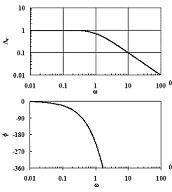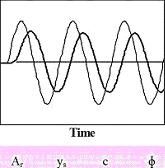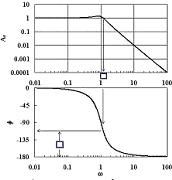![]()
![]()
![]()
Use LEFT and RIGHT arrow keys to navigate between flashcards;
Use UP and DOWN arrow keys to flip the card;
H to show hint;
A reads text to speech;
19 Cards in this Set
- Front
- Back
|
As frequency increases:
Amplitude ratio decreases Phase angle is negative if ys lags c |

.
|
|

_
|

_
|
|
|
ωco - crossover frequency
PM - phase margin |

.
|
|
|
Time difference between peaks can be converted into the
|
Phase angle of response
|
|
|
Time difference between peaks is assumed positive in phase angle equation when
|
c lags ys
|
|
|
Bode plot of a process is a plot of _____ and the logarithm of _______ vs. the logarithm of _______
|
plot of phase angle and
logarithm of amplitude ratio vs. logarithm of frequency (rad/time) |
|
|
System with greater gain margin
|
Can withstand greater changes in system parameters before becoming unstable in closed loop
|
|
|
Phase Margin
Measures the system's |
Determines the phase angle at the crossover frequency
Tolerance to time delay |
|
|
A system is stable if
|
Ar is less than 1.0 at the frequency where phase angle = -180˚ (critical frequency)
GM > 1 PM > 0 |
|
|
Critical frequency
|
Frequency (w) at which the phase angle = -180º
If Ar < 1 at wc, system is stable |
|
|
Gain Margin =
|
1/Ar*
Where Ar* is the amplitude ratio at the critical frequency. |
|
|
Controllers are typically designed with gain margins in the range of ___ which implies that ___ at the critical frequency varies between ______
|
1.4 to 1.8
Ar 0.7 and 0.55 |
|
|
System is stable when A*r is
|
Less than 1, GM > 1
|
|
|
When GM = 1
When PM = 0 |
Sustained Oscillations
|
|
|
Gain Margin is to ____ as Phase Margin is to
|
GM = 1/A*r
PM = f* - (-180 |
|
|
Phase margin is the difference between
|
The phase angle corresponding to Ar = 1 and a phase angle of –180˚
PM = f* + 180˚ where f* is the phase angle corresponding to Ar=1 |
|
|
Crossover frequency
|
ωco
Frequency that corresponds to Ar = 1 |
|
|
Typical values used for tuning:
GM PM |
GM: 1.4 - 1.8
PM: 30˚ - 45˚ |
|
|
GM and PM for tuning similar to ______ in that
|
Decay ratio
The more nonlinear a process and the larger the magnitude of disturbance, the larger the values of PM or GM used. |

